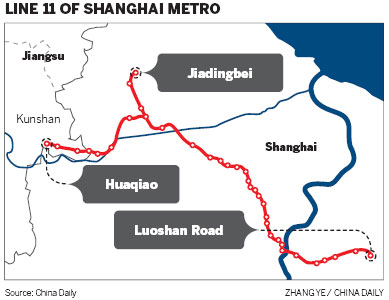A new subway route that connects Shanghai and Jiangsu province will boost economic integration in the region and encourage more people to take the metro, experts said.
The route, an extension of Shanghai's subway line 11, opened on Wednesday for a trial run linking the country's commercial hub and Jiangsu's Kunshan, a booming county-level administration.
"It integrates people living and working in the Yangtze River Delta region and boosts regional development," said Yu Hongsheng, director of the Urban Development Research Center under the Shanghai Academy of Social Sciences.
Spanning 6 kilometers, the extension takes only 7 minutes to travel from the last stop in Shanghai, Anting station, to Kunshan.
The extended route makes stops at three new, elevated stations at Zhaofeng Road, Guangming Road, and Huaqiao station, all in Kunshan.
Escalators, elevators, public restrooms, and air-conditioned waiting rooms have been built at each new station.
From Huaqiao station, residents can travel to the commercial Xujiahui district in downtown Shanghai in about one hour.
The extension brings the total length of Shanghai's metro network to 468 kilometers with a total of 303 stations.
As China's first interprovince subway route, the new line will help break the deadlock set by different administrative divisions and benefit both Shanghai's and Kunshan's economies, experts said.
"Compared with Shanghai, the housing prices and commercial costs have remained low in Kunshan," said Zhou Weilin, a professor of economics at Fudan University. "The new line will definitely promote Kunshan's tourism, employment and its commercial links with Shanghai."
The new line will also make it easier for Shanghai to shift its low-end manufacturing businesses during its pursuit to develop its financial sector, he added.
It is a good start and its success will see a city cluster linked by subways and further break the administrative barrier, he said.
More cities in Jiangsu, including Suzhou and Wuxi, have outlined rapid transit rail routes to link with Shanghai's metro lines.
On Wednesday, residents and company owners said the new extension brought great convenience to their lives.
Wang Jia is an office clerk in Shanghai but lives near Huaqiao, a town located in eastern Kunshan.
"Before the new extension opened, I had to take a bus to Anting, take line 11 and then shift to other lines to travel to my destination," he said. "The extension to Huaqiao will greatly shorten my daily commute."
Lee Han-ling, a manager from Taiwan at Hongta Textile Co in Kunshan, said the line saves both time and money for the thousands of people who need to travel between Shanghai and Kunshan on a daily basis.
"Businessmen in Kunshan make frequent business trips to Shanghai because of the cities' close business connection. Although the high-speed railway is good, it takes a lot of time to check in, wait, and get to your destination," he said.
"Sometimes we chose to drive, only to find that we were caught in a serious traffic jam."
Lee suggested to extend the subway further into downtown Kunshan, as most of the factories, including his textile factory, are clustered downtown rather than in Huaqiao.
Contact the writers at wangzhenghua@chinadaily.com.cn and wang_ying@chinadaily.com.cn

(China Daily 10/17/2013 page3)


